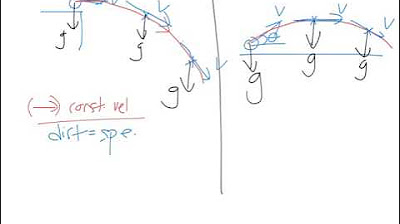Describing Free Fall
Summary
TLDRThis video tutorial on kinematics explores free fall motion, defining it as the motion of objects falling solely under the influence of gravity, with a constant acceleration of approximately 9.8 m/s². It discusses how the velocity of an object changes as it falls, including representations through dot diagrams, velocity timetables, and graphs. The tutorial also covers objects thrown upwards, highlighting the symmetry of ascent and descent times. Viewers are encouraged to engage with practice problems and resources to solidify their understanding of these fundamental concepts in physics.
Takeaways
- 😀 Free fall is the motion of an object falling solely under the influence of gravity, without significant air resistance.
- 😀 A free-falling object accelerates downwards at a constant rate of 9.8 meters per second squared, known as the acceleration due to gravity.
- 😀 The acceleration of free-falling objects is independent of their mass, direction, or speed.
- 😀 In a dot diagram, the spacing between dots increases as an object falls, indicating that it is speeding up.
- 😀 Velocity changes for free-falling objects can be represented in a velocity-time graph, which shows a linear increase in velocity over time.
- 😀 When an object is thrown upwards, it slows down until it reaches its peak, after which it accelerates downwards again.
- 😀 The velocity vector of a free-falling object always points downwards, while the acceleration vector remains constant and also points downwards.
- 😀 The speed of an object is greatest at the lowest points of its trajectory and zero at the peak of its motion.
- 😀 The time taken to rise to the peak is equal to the time taken to fall back down to the same height.
- 😀 Practical calculations can use the approximate value of 10 meters per second squared for the acceleration of gravity for quick estimations.
Q & A
What is free fall motion?
-Free fall motion is the motion of an object that is falling under the sole influence of gravity, with negligible air resistance.
How does the acceleration of a free-falling object behave?
-The acceleration of a free-falling object is constant at approximately 9.8 meters per second squared, directed downward, regardless of the object's mass.
What happens to an object's velocity as it rises and then falls?
-As an object rises, its velocity decreases until it reaches its peak (where the velocity is zero), and then as it falls, its velocity increases.
Why does mass not affect the acceleration of free-falling objects?
-Mass does not affect acceleration in free fall because all objects experience the same gravitational force per unit mass, leading to the same acceleration due to gravity.
What graphical representations can be used to describe free-fall motion?
-Graphical representations include dot diagrams showing increasing dot spacing as the object falls, velocity timetables, and velocity-time graphs indicating constant acceleration.
How can you calculate the time it takes for an object to reach its peak height when thrown upwards?
-The time to reach peak height can be calculated by dividing the initial velocity by the acceleration due to gravity (approximately 10 m/s²).
What does a velocity-time graph for a free-falling object look like?
-A velocity-time graph for a free-falling object is a linear graph that slopes downward, with a slope equal to the acceleration of -9.8 m/s².
In free fall, what is the relationship between the time taken to rise and the time taken to fall?
-The time taken to rise to the peak height is equal to the time taken to fall back down to the same height.
What is the initial velocity of an object thrown upwards if it reaches a height in three seconds?
-If an object reaches its peak in three seconds, the initial velocity can be approximated as 30 meters per second upwards.
How can viewers further their understanding of free fall after watching this video?
-Viewers can visit the website's Concept Builders section, engage in activities from the Science Reasoning Center, or refer to the Physics Classroom Tutorials for written references.
Outlines

This section is available to paid users only. Please upgrade to access this part.
Upgrade NowMindmap

This section is available to paid users only. Please upgrade to access this part.
Upgrade NowKeywords

This section is available to paid users only. Please upgrade to access this part.
Upgrade NowHighlights

This section is available to paid users only. Please upgrade to access this part.
Upgrade NowTranscripts

This section is available to paid users only. Please upgrade to access this part.
Upgrade NowBrowse More Related Video

Física: Movimiento Vertical - Traful Utemvirtual

kinematics 6of6 projectile motion final

Kinematic Equations in One Dimension | Physics with Professor Matt Anderson | M2-04

Movimento Uniformemente Variado I (MUV) - Cinemática - Aula 7 - Prof. Boaro

Falling objects | Physics | Khan Academy

QUEDA LIVRE e LANÇAMENTO VERTICAL - [Física do ZERO]
5.0 / 5 (0 votes)